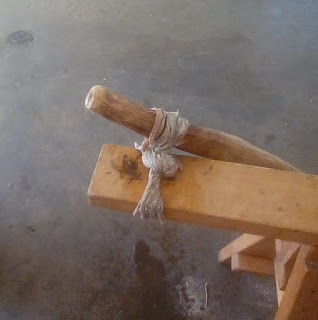Buckskin Care and Waterproofing
If the hide is constantly exposed to water, or is often wet, it will rot - not nessissary stink -and fall apart; like for moose hide moccasins; this won't take very long at all.
Use dry antler or metal to hang the hide on; on that note, if you hang on metal, cover with a rag first or the metal will stain your buckskin hide.
I have found that constant use and exposure to various conditions will keep the “black spot mould” away. I used to hobby ferment and a sure way to create an environment for a really nasty organism was to cook, but not fully sterilize a food item and store it in a closed container. This allowed the hardier bad organisms to take over. If there was a diverse organism population, neither would take over and it wouldn’t smell, that bad. This MAY be similar to hides. It may also be why it is recommended to use rotting wood while smoking as the rot spreads, in a counter intuitive way, a diverse spectrum of fungi to the hide.
What is far more likely the case is that when a buckskin is used, there is more time for sun to beat down on the surface. UVc (one of the sun's uv wavelengths) will "kill" mold spores because it will "penetrate the cell walls". It is said that only two hours is enough from what I suspect is a direct source of uvc, onto the mold (like a lamp) - I use the sun.
When you want to prevent any mold from taking a foothold, or if it already has and you want to stop it - slam it with direct rays from the sun for a few hours.
If you develop the speckle black mold, you may consider discarding the item as it WILL rapidly spread to other hides.
On the other hand, if you are worrying about mold when outdoors you cant enjoy the adventure of being in the bush with buckskins.
If you check it with sun rays, the black mold will still leave a stain on the leather, but the sun will stop it from getting any worse; particularly with repeated and cautionary treatments; you can use this trick on commercial leather as well.
When your mosquito smudge or small bush fire is smoking, use a stick or two to hang your mocs in the smoke. This will keep the smoke up in an item that will be constantly exposed to water where it is washing out.
Stay out of heavy rain with buckskin garments. Get under a tree during heavy rain. Dry (un greased) buckskin will never be a rain jacket.
Blood and dry mud can be scraped away with a sharp tool.
If the hide ever lightly stiffens, just rough it with your hands and wear.
Repeat water exposure, unless the skin is in a high traffic area, will stiffen buckskin - there is no way around this - except, tallow. Even a high traffic area with reapeat water exposure will dry the fibers.
Using waste tallow - as good tallow should be eaten - to waterproof buckskin, will make it look dirty, and oily and a bit like commercial leather, but greasing your buckskin will make it permanently waterproof and (basically) forever flexible. I havent experimented with this too much, but that's the only natural way to waterproof it.
The key is to use a fat that will stay put in water. Vegetable oils, brain matter, marrow, and even bear grease to some degree, will stay liquid at cooler temperatures and so wash out when water is present; tallow will not and so it will stay put in rain and river water.
A good way to put on a buckskin hoody is to put both arms first, then pull the garment over your head; this will prevent the seams from undue stretching or tearing.




